Grizzly bears are some of the largest predators on Earth, but did you know that 90% of their diet is vegetation? Or that a grizzly bear’s sense of smell is 2,100 times greater than a human’s? We’re digging into 10 of the most incredible grizzly bear facts! Here’s a preview:
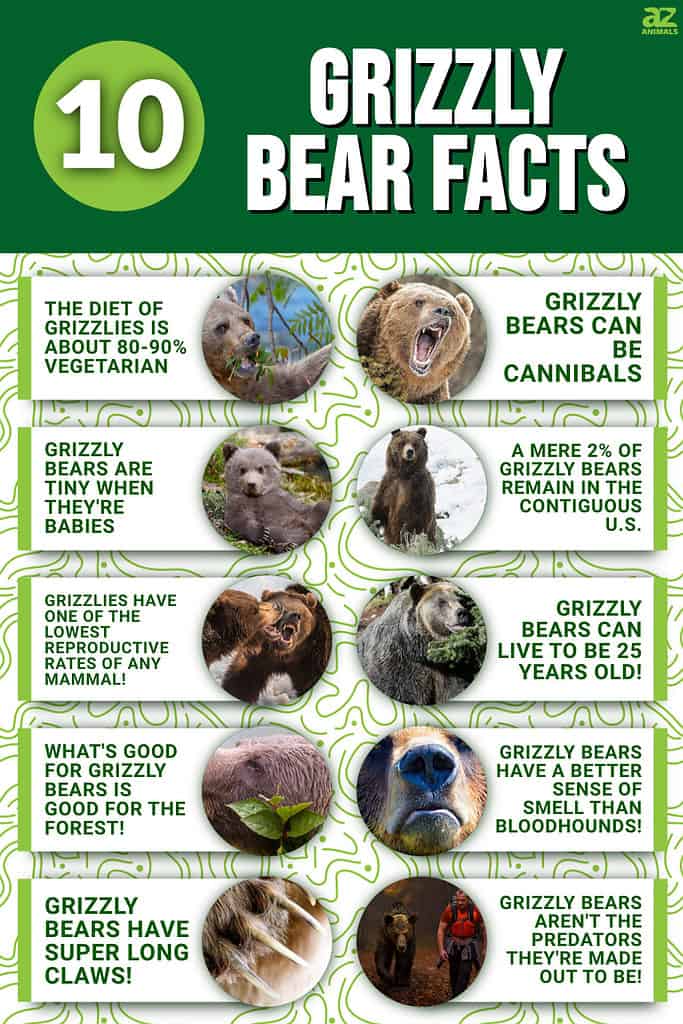
Now read on to enjoy more detail about these amazing animals.
1. The Diet of Grizzlies Is About 80-90% Vegetarian

A grizzly bear is an omnivore that actually eats little meat but lots of vegetation.
©ovbelov/Shutterstock.com
When most people think of grizzly bears, they assume they are strictly carnivores. With those teeth and that snarl, they sure can be a threatening predator to some. Surprisingly enough, grizzly bears aren’t carnivores, but omnivores, eating a mix of plants and animals.
In the small corners of the world where grizzlies still roam the land freely, they exist primarily on a plant-based diet. Grizzly bears actually consume an average of 20% or less of meat and flesh.
From berries to grass and roots, grizzly bears will graze for all of the delicacies nature has to offer.
2. Grizzly Bears Can Be Cannibals
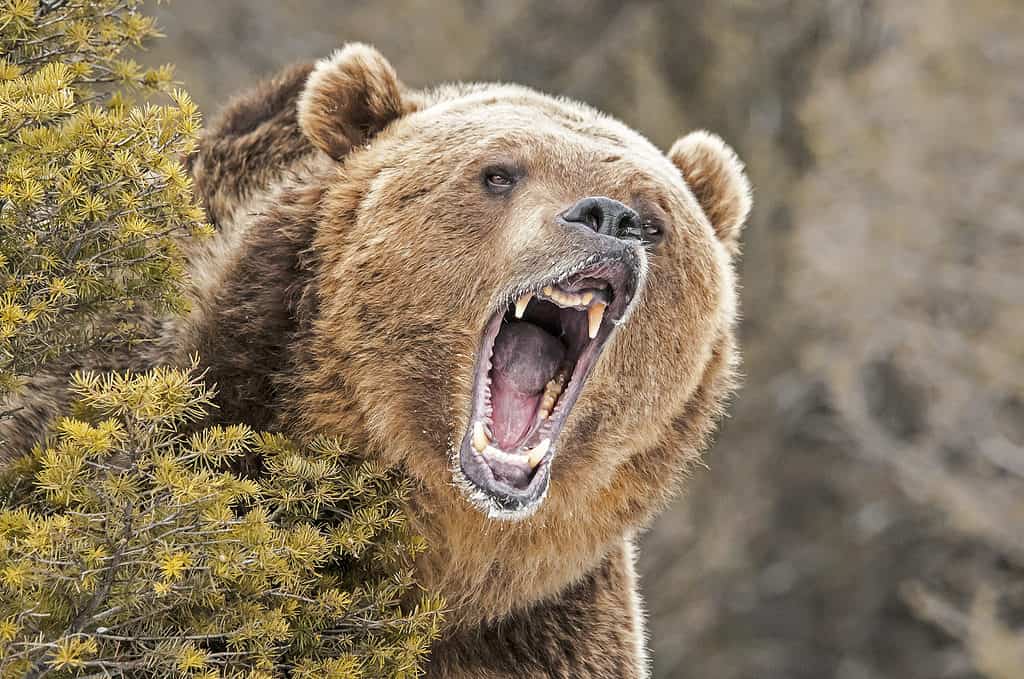
Grizzly bears will sometimes kill and eat the young of a female they want for a mate.
©Scott E Read/Shutterstock.com
Cannibalistic bears may sound a bit dramatic, but the truth is that grizzlies sometimes eat their own young and smaller species of bears.
Many male animals kill and eat their young or the young of others; this is called infanticide, showing an instinctual and callous side of grizzlies that many don’t want to see.
Sexually selected infanticide has been documented in grizzly bears as well as other species. In this mating system, males have close to exclusive breeding rights with at least one female. Often when the dominant male isn’t around, another kills the offspring of the dominant male in an attempt to take the female as his own.
3. Grizzly Bears are Tiny When They’re Babies
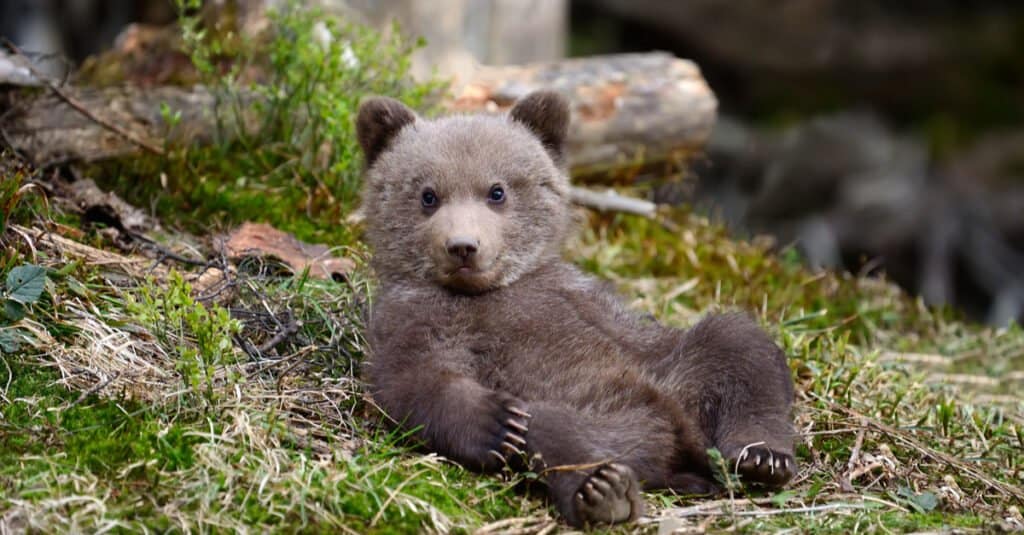
A grizzly bear cub after bulking up from plenty of mother’s milk.
©Volodymyr Burdiak/Shutterstock.com
Grizzly bears are a subspecies of the brown bear scientifically named Ursus Arctos. When brown bears are born, they weigh about one pound which is surprisingly low considering they weigh at least 400 times that in adulthood.
Grizzly bear cubs are very vulnerable, born without fur or the sense of sight. Bear cubs bulk up quickly since mother’s milk consists of about 33% fat.
4. A Mere 2% of Grizzly Bears Remain in the Contiguous U.S.
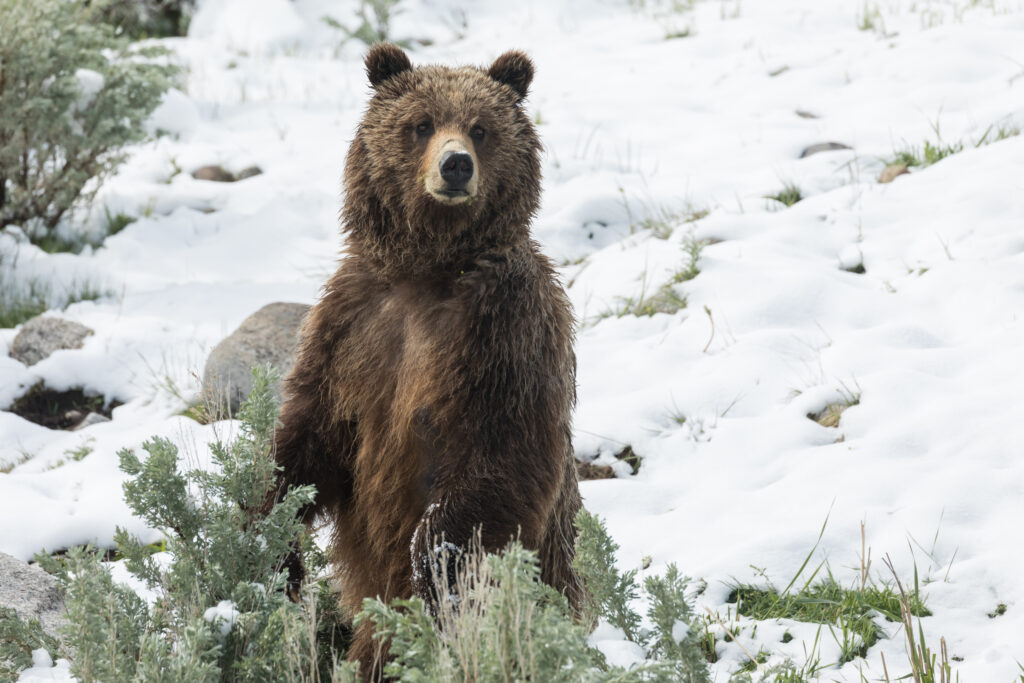
The grizzly bear is most often found in parts of Canada and Alaska where there is lots of snow!
©Kelp Grizzly Photography/Shutterstock.com
Many believe grizzly bears have existed for at least 20,000 years now, yet their fate lies in the hands of humans. The grizzly population is estimated at 50,000 animals in North America, with only about 1200 grizzly bears found in the lower-48 of the United States.
From 1850 to 1920, 95% of the natural grizzly bear habitat in the United States had been eliminated by European settlers. After that time, the grizzly population took another steady hit from 1920 – 1970 due to unregulated hunting. In total, 98% of the grizzly bear range in the contiguous U.S. has been eliminated in the last 100 years.
British Columbia, western Alberta, the Yukon, the Northwest Territories, and Alaska are the primary areas of distribution of North American grizzly bears.
5. Grizzlies Have One of the Lowest Reproductive Rates of Any Mammal!
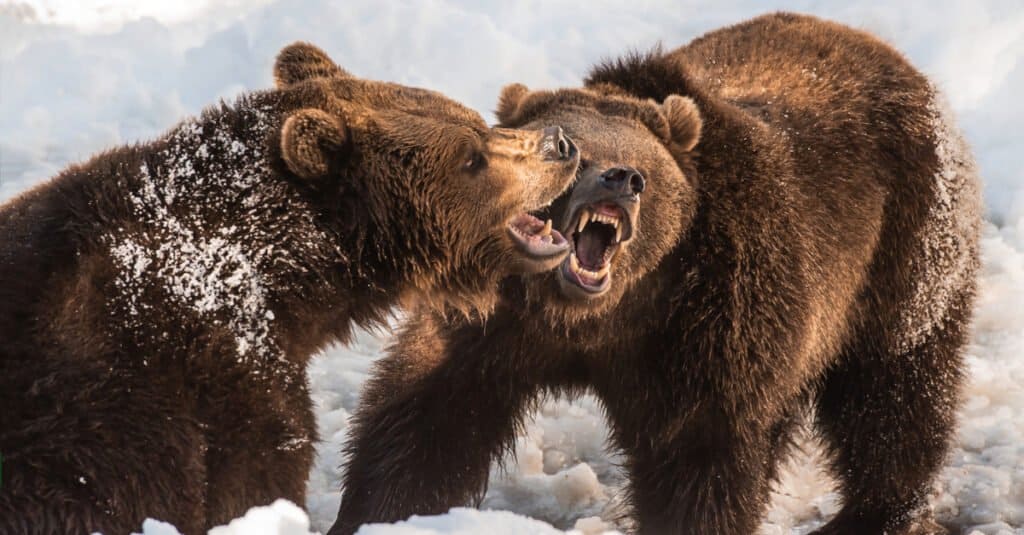
Grizzlies have incredibly low reproductive rates
©Alexandra Giese/Shutterstock.com
Grizzly bears don’t reach sexual maturity until 4-1/2 – 10 years of age! That 1/6 to 1/3 of their life that they are not mating. Some young bears may even need an additional year to 18 months to reach full sexual maturity.
Unlike cats and dogs, which reach sexual maturity at a mere 5 to eight months, bears spend a large part of their lives sexually immature, leading to some of the lowest reproductive rates of any mammal.
6. Grizzly Bears Can Live to Be 25 Years Old!
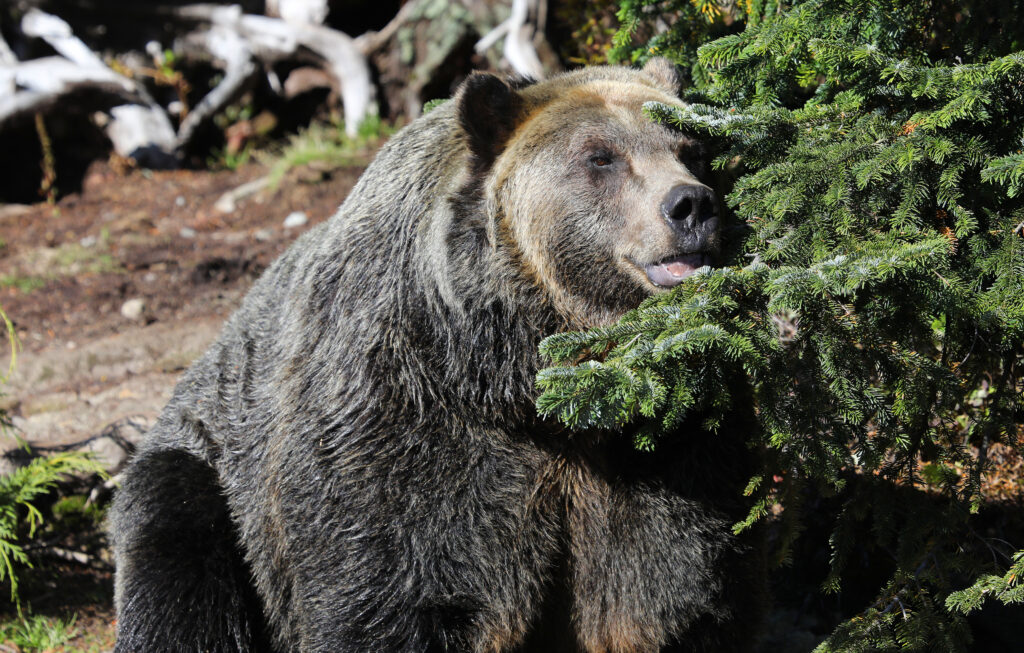
A grizzly bear can live 15-25 years, normally, if they can maintain a stable living situation.
©Jacqui Martin/Shutterstock.com
The oldest bear reported recently was estimated at 34 years old. Typically, however, bears live to be 15 – 25 years old in the wild. That’s if they don’t find an early end at the hands of humans or climate change.
Because bears need such a large area to live in, it can be challenging to maintain a stable living situation. Luckily, there are many brown bear conservation sites and ranges around the globe. These conservation ecosystems allow bears to roam freely in their natural habitat, undisturbed and with a minor threat.
7. What’s Good For Grizzly Bears is Good For the Forest!
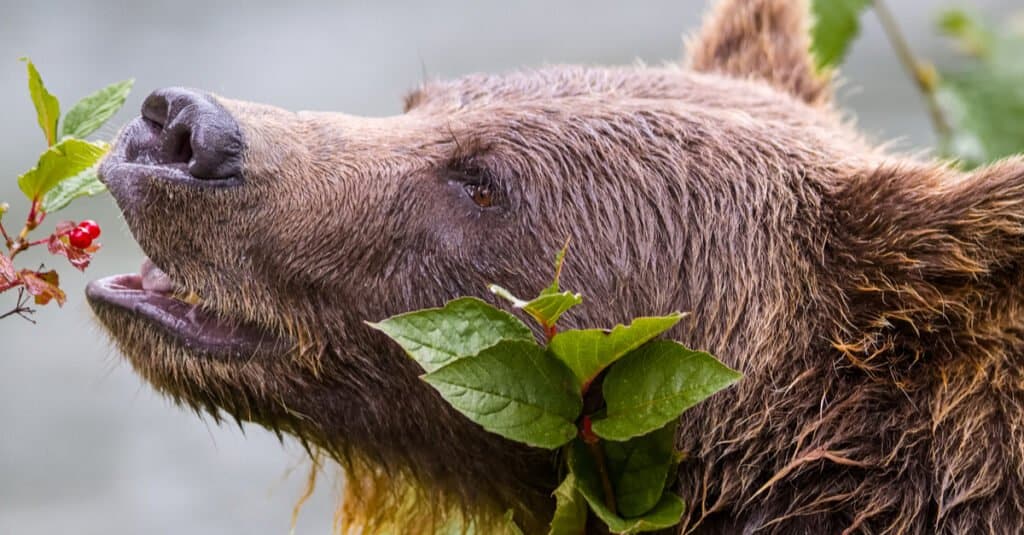
A grizzly feasting on berries
©Martin Rudlof Photography/Shutterstock.com
Grizzly bears are an essential part of the wooded and mountainous ecosystems of which they are part. Grizzlies are eating more and more berries due to climate change and the timing of the seasons. However, they are dispersing the undigested seeds throughout the forest, complete with manure fertilizer to aid in the growth process!
Grizzlies even do their part in composting. Not in a leak-proof container like we do; they pull their weight. The grizzly bears dig and stir up the dirt, scavenging for carcasses winter has left behind as well as ground-dwelling rodents. Bears forage for roots, bulbs, and grasses, increasing alpine ecosystems’ nitrogen levels and creating richer soil.
8. Grizzly Bears Have a Better Sense of Smell Than Bloodhounds!

The grizzly bear’s nose outperforms a bloodhound’s acute sense of small.
©meunierd/Shutterstock.com
Even the average dog can smell about 100 times better than a human, and bloodhounds hold the title for the best sniffer in the canine species. It may blow your mind to know that a bear’s sense of smell outperforms the bloodhound’s by seven times, which means a bears’ sense of smell is 2,100 times superior to a human’s!
9. Grizzly Bears Have Super Long Claws!
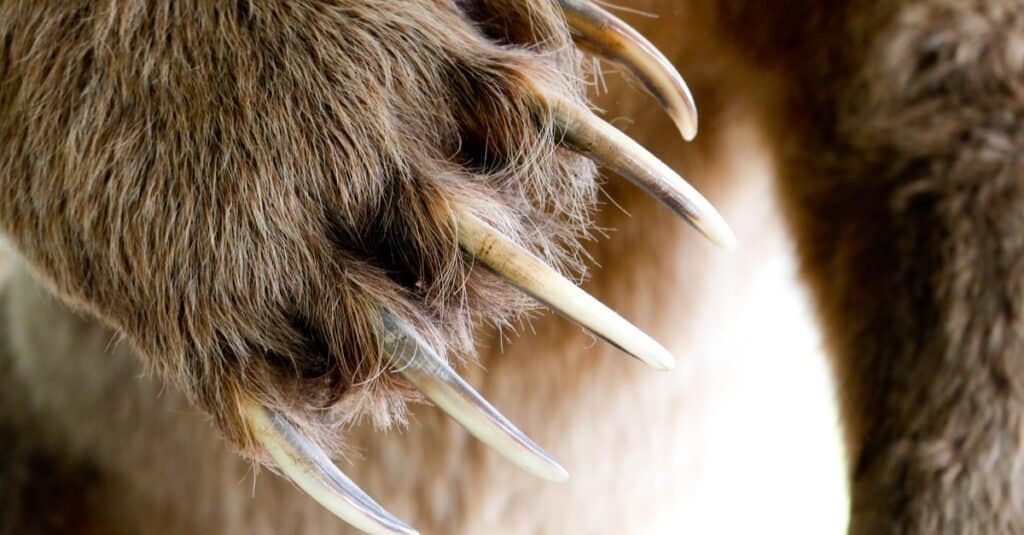
Grizzly bear paws have incredibly law claws!
©TheWonderWays/Shutterstock.com
Yes, the grizzly bear is simply a type of brown bear, but there are specific characteristics that only the grizzly encapsulates. One of these being their massive claws that can grow to be 4 inches long! That’s as long as a human finger, but it has a sharp point at the end!
Other unique characteristics of the grizzly bear are the dished nose or concave dip between the eyes and the tip of their nose.
Grizzly bears also have the signature grizzly hump between their shoulders. Grizzlies develop larger than average definition from turning over rocks and using their shoulder muscles often.
10. Grizzly Bears Aren’t the Predators They’re Made Out to Be!
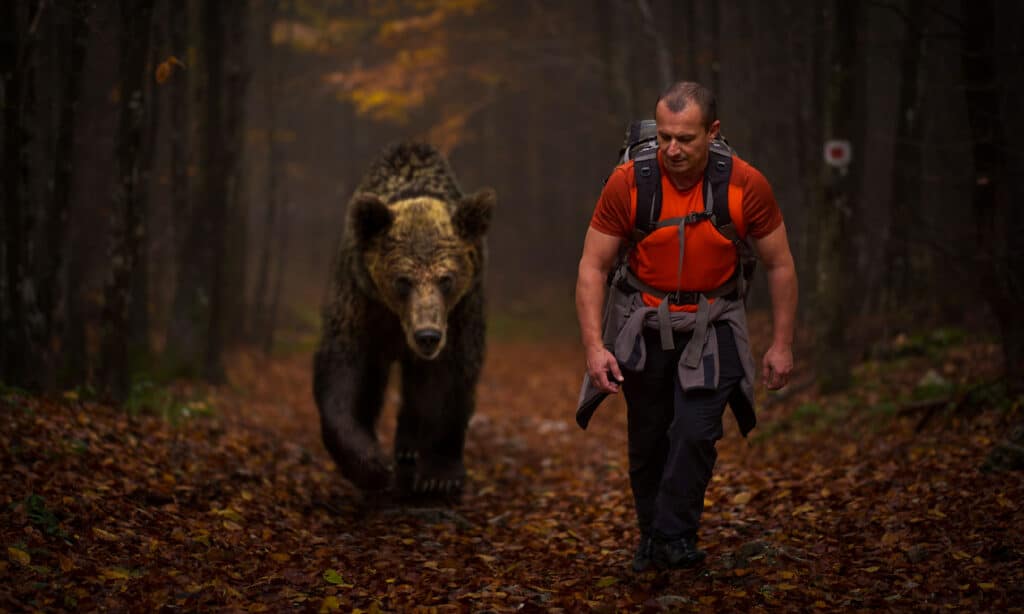
It is not common for a hiker and a grizzly to walk together, but still, grizzlies don’t normally stalk humans.
©iStock.com/xalanx
We’ve all heard of grizzly bear attacks in the mountains, but in truth, grizzly bear attacks are usually a response to fear or feeling threatened. Just as with humans, grizzly bears don’t like to be surprised in their homes.
Grizzlies will show their fierce side if they believe their bear cubs, food or shelter are threatened, but they aren’t interested in stalking human flesh as some dramatizations may suggest.
Campers and hikers in areas with grizzlies often carry bear sprays to deter aggressive run-ins with these massive and handsome creatures. Making some noise on the trail will alert bears that you’re approaching and give them ample time to take off.
The photo featured at the top of this post is © Alexandra Giese/Shutterstock.com
Thank you for reading! Have some feedback for us? Contact the AZ Animals editorial team.






